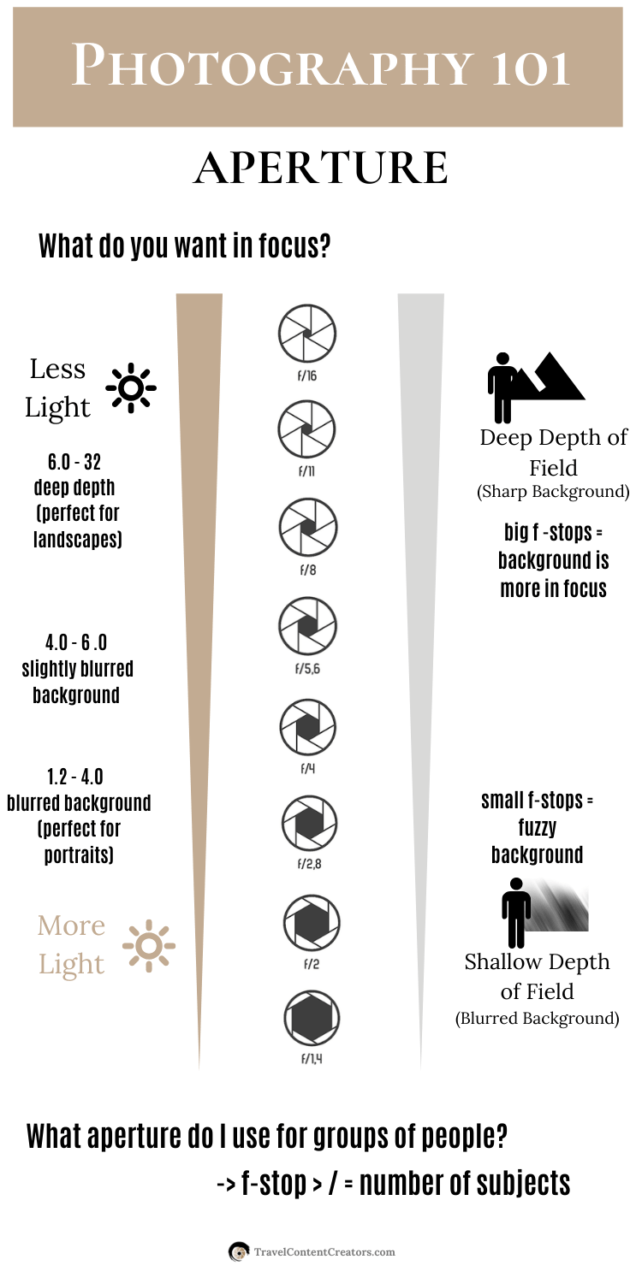F Stop And Shutter Speed Cheat Sheet
The aperture does more than let adequate light in your shot: it also helps you control how much of the scene appears sharply focused.
Whether you're shooting in manual or aperture priority mode, setting the right aperture to put depth of field to work is one of the decisions you'll have to make with confidence. Whatever the kind of photography you do, your choice of aperture will determine not only how bright your results look, but also how much of the scene appears sharply focused. It's one of the topics we cover a lot in our tutorials and cheat sheets, but in case you need a less technical visual guide, today's featured photography cheat sheet will serve as another quick reference to help you better understand how aperture works.
The photography cheat sheet below is part of the photography basics guide by Travel Content Creators. There, they first explain the role of aperture nicely. As we all know by now, our cameras work with light, and the aperture is "basically the first hurdle for the light when it passes the lens to get inside your camera." The other is shutter speed, while ISO determines how bright your photo looks. Together, they work as the Exposure Triangle, which explains that changing one element means you have to compensate with one or both of the other elements. For aperture, you might want to try adjusting the shutter speed if you want to keep the ISO to a minimum and avoid grain or noise.
But, as the quick guide below illustrates, you can also use aperture to control the depth of field and produce either a sharp background or a blurry background. This opens up your photography to a lot of creative possibilities, especially if you decide to break away from your camera's auto mode.

How Apertures and F-Stops Work
First, the cheat sheet reminds us that small apertures or higher f-stops like f11 and f16 let in less light, but also produce a deep depth of field. In these settings, you can achieve sharp focus throughout your frame, from the foreground to the background. It works especially well if you set the focus to the hyperfocal distance of your lens. These qualities make small apertures perfect for landscape photography, but you'll need to use a tripod to prevent camera shake.
Bokeh

Meanwhile, if you only want to blur the background slightly but still get more of the scene in focus — as is the case for genres like environmental portraits and documentary photography — you can use f4 or f5.6. But, if you want a beautiful separation of your subject from the background — typically useful for portraits and macro photography — wide open apertures of f1.4 to f1.2 are your best bet. As a bonus, these apertures will also allow you to achieve dreamy bokeh when shooting against the city lights at night.
One last tip from today's guide, which we're sure will come handy for everyone once in a while. When photographing groups of people, the rule of thumb is to set the aperture according to the number of subjects in your shot. That should make sure everyone is in focus!
If you liked today's handy guide, we invite you to check out our growing collection of photography cheat sheets for more useful tips and tricks!
F Stop And Shutter Speed Cheat Sheet
Source: https://www.thephoblographer.com/2020/06/16/photography-cheat-sheet-how-to-figure-out-what-aperture-you-need/
Posted by: herreralefterim.blogspot.com

0 Response to "F Stop And Shutter Speed Cheat Sheet"
Post a Comment